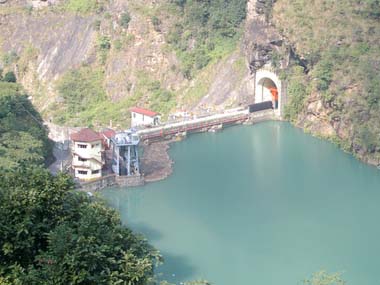A disaster, unfortunately, is an opportune time to visit certain issues. Sunday’s earthquake gives us reasons to look at the issue of dam safety in India. True, the quake didn’t have an adverse affect on any of Sikkim’s dams. But then, that was probably sheer luck. A quake-hit dam can be a catastrophe of untold proportions - which I’m sure no one needs to be told. Reports from Sikkim have been slow in trickling out, but there has been one report of one National Hydroelectric Power Corporation (NHPC) dam developing cracks. Gushing waters have reportedly inundated low-lying areas forcing hundreds of families to flee for their lives. [caption id=“attachment_88084” align=“alignleft” width=“380” caption=“Image from sikkimonlineinfo.com”]  [/caption] For years, NHPC officials and those at the Ministry of Water Resources have been trying to assure us that their dams are earthquake proof. But this is hardly reassuring. Sunday’s quake in Sikkim was the largest to hit the state in the last 20 years. What if the next one (god forbid) is bigger? There are innumerable instances of dams in China developing cracks after quakes. These reports are always suppressed in true Chinese fashion. But anyone who works with dams is only too aware of the fact that dams are always vulnerable to quakes. What makes the scenario scarier is that India still does not have a Dams Safety Act in place. The landmark report of the World Commission on Dams titled, ‘Dams and Development: a new framework for decision-making’, was released in 2000. That ought to have set decision-makers in India acting. But the tardy progress on the issue indicates that they are still thinking. In July this year, the Standing Committee on Water Resources submitted its seventh report on the Dam Safety Bill, 2010. (Yes, you read that right: seventh.) The panel found glaring gaps in the Bill text. This was not surprising. Various governments at the Centre have been dilly-dallying on the issue for decades. A similar committee had submitted its ‘Report on Dam Safety Procedures’ in July 1986. A draft Dam Safety Bill was prepared by the Central Water Commission the following year. A modified version came through in 2002. Only the states of Andhra Pradesh, Bihar and West Bengal were pro-active about the issue. The Dam Safety Bill, 2010 was introduced in Lok Sabha on August 30, 2010. As of now, it is in limbo. The Bill says in the event of failure of a dam or the dam owner not obeying the directions/provisions of the Bill, the responsibility would be completely on the owner of the dam. However, there is no mention of the penalty to be imposed on such owners. In other words, the environmental criminal can escape scot free. There is also no provision in the Bill to compensate affected people in case of any disaster that may take place due to the failure of the dam. The draft also talks of ‘safeguarding of human life, livestock and property‘, but safety of aquatic life and natural resources which would also be adversely affected due to dam failures has not found any mention. The term, ‘safety assurance‘, is not mentioned anywhere either. The Standing Committee felt that on the lines of the Nuclear Safety Bill, the safety assurance which is an undertaking of pre-emptive action in order to prevent any accident, given the ecology of the dams and the impact on the dams, should be suitably incorporated in the Bill. Most worryingly perhaps, there is no mention of standards or practices to be followed in designing or evaluating the safety of dams. In the absence of standards, different agencies/states would naturally follow different yardsticks. Standard codes and guidelines ought to be mandatory. Worse, the Bill provides for ‘comprehensive dam safety evaluation’ of each dam by the owner through their own engineers. This leaves enough room for the negligent and irresponsible to escape. Anyone directly or indirectly connected with the maintenance or ownership of the dam at any stage should not be associated with the evaluation of dam safety. Concerns of dam activists have not been addressed by the Standing Committee either. And mind you, this only concerns the issue of dam safety, and does not look into other aspects of dams like rehabilitation and environment. Today, this is only a Bill, and had this even been an Act, those responsible for the breach in the dam in Sikkim that developed cracks would escape without so much as a scratch. Dam lobbyists who try to skirt environmental concerns and safety issues, and turn a blind eye towards local communities, usually take refuge in the populist bogey that anyone opposing a dam is anti-development. Let’s call them environmental demagogues, shall we? The bottom line, however, remains: the issue of dams is too important and serious to be left to water resources or power experts.
A quake-hit dam can be a catastrophe of untold proportions. There have been seven draft bills so far but no Dams Safety Act in India. Are we serious?
Subir Ghosh is a regular commenter on Firstpost.com and one of our first guest bloggers. He is a New Delhi-based independent journalist and writer. He has worked with the Press Trust of India (PTI) and The Telegraph, and handled publications/communications for the Centre for Science and Environment (CSE), the Federation of Hotels and Restaurant Associations of India (FHRAI), and the Wildlife Trust of India (WTI). He specialises in Northeast affairs and is an advisory council member with the Centre for Northeast Studies (C-NES). He is the author of 'Frontier Travails: Northeast - The Politics of a Mess' published by Macmillan India, and has won two national awards in children's fiction. His subjects of interest include conflict, ethnicities, wildlife, human rights, poverty, media, and cinema. He blogs at www.write2kill.in</a>, and designs websites during his off hours. see more


)
)
)
)
)
)
)
)
)



